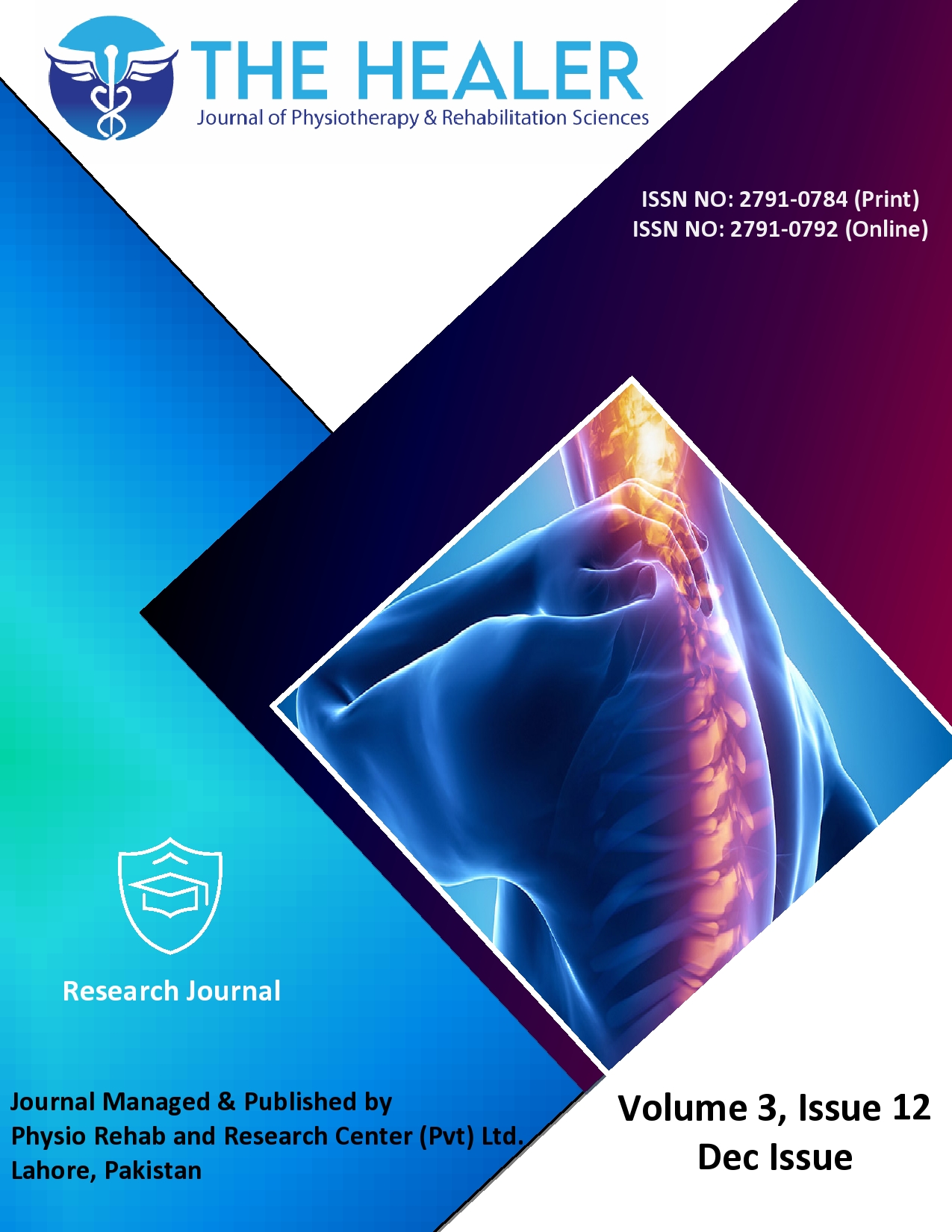Comparative Effects of Routine Physical Therapy versus Intra-Articular Steroids in Patients with Chronic Frozen Shoulder
Physical Therapy vs Intra-Articular Steroids in Frozen Shoulder
DOI:
https://doi.org/10.55735/hjprs.v3i12.222Keywords:
frozen shoulder, physiotherapy, stiffnessAbstract
Background: Frozen shoulder presents clinically as shoulder pain with progressive confined movement, both active and passive, along with normal radiographic scans of the glenohumeral joint. Frozen shoulder is a common problem in current healthcare practice. The condition for a long time is ill-diagnosed and treated by painkillers without assessing the exact problem in the joint. Objective: To compare the effects of routine physical therapy versus intra-articular steroids in patients with chronic frozen shoulders. Methods: A quasi-experimental study was conducted in an Orthopaedic Center in Shujabad in June 2023. The age range of the participants was 25 to 55 years. The sample size was 78 patients using a non-probability purposive sampling technique and were divided into two groups with 39 in each group. The Numeric Pain Rating Score, Shoulder Pain and Disability Index and goniometer were used as a tool for data collection. The subjects were asked for follow-up on the 15th day twice in the 1st month then at the end of the 2nd and 3rd month for follow-up and assessment. Mann-Whitney U test and Friedman tests were applied. Descriptive data is presented as frequency and percentages. Results: The p-value of the Friedman test is less than 0.05 so a statistically significance difference is found in Group B before, during and after intervention. According to the Mann-Whitney U test, the p-value of the SPADI score baseline is more than 0.05 which shows that no statistically significance difference is found in both groups' baseline SPADI score. The mean rank of Group A is less than Group B which shows that there is more improvement in Group A as compared to Group B. Conclusion: According to the results, this study concluded that the data collected through Shoulder Pain and Disability Index, the disability index and pain perception were the main outcomes of our study. When we saw group A with conventional physical therapy protocol the outcome was far better in terms of disability limitation and decrease in pain. The joint range of motion in frozen shoulder completely gained after physiotherapy but intra-articular steroid group B only reduced pain.
Downloads
References
Anjum R, Aggarwal J, Gautam R, Pathak S, Sharma A. Evaluating the Outcome of Two Different Regimes in Adhesive Capsulitis: A Prospective Clinical Study. Medical principles and practice : international journal of the Kuwait University, Health Science Centre 2020; 29(3): 225-30.
Hammad, S. M., Arsh, A., Iqbal, M., Khan, W., & Shah, A. (2019). Comparing the effectiveness of kaltenborn mobilization with thermotherapy versus kaltenborn mobilization alone in patients with frozen shoulder [adhesive capsulitis]: A randomized control trial. JPMA. The Journal of the Pakistan Medical Association, 69(10), 1421-1424.
Robinson CM, Seah KTM, Chee YH, Hindle P, Murray IR. Frozen shoulder. The Journal of Bone & Joint Surgery British Volume 2012; 94-B(1): 1-9.
Mertens MG, Struyf F, Meert L, et al. Factors influencing treatment outcome of physical therapy in frozen shoulder patients: a systematic review. European Journal of Physiotherapy 2022; 24(3): 174-90.
Anton H. Frozen shoulder. Canadian family physician 1993; 39: 1773.
Russell S, Jariwala A, Conlon R, Selfe J, Richards J, Walton M. A blinded, randomized, controlled trial assessing conservative management strategies for frozen shoulder. Journal of Shoulder and Elbow Surgery 2014; 23(4): 500-7.
Do Moon G, Lim JY, Da YK, Kim TH. Comparison of Maitland and Kaltenborn mobilization techniques for improving shoulder pain and range of motion in frozen shoulders. Journal of Physical Therapy Science 2015; 27(5): 1391-5.
Favejee M, Koes B. Frozen shoulder: the effectiveness of conservative and surgical interventions—systematic review. British Journal of Sports Medicine 2011; 45(1): 49-56.
Lädermann A, Piotton S, Abrassart S, Mazzolari A, Ibrahim M, Stirling P. Hydrodilatation with corticosteroids is the most effective conservative management for frozen shoulder. Knee Surgery, Sports Traumatology, Arthroscopy 2021: 1-11.
Kelley MJ, Mcclure PW, Leggin BG. Frozen shoulder: evidence and a proposed model guiding rehabilitation. Journal of Orthopaedic & Sports Physical Therapy 2009; 39(2): 135-48.
Cho C-H, Bae K-C, Kim D-H. Treatment strategy for frozen shoulder. Clinics in Orthopedic Surgery 2019; 11(3): 249-57.
Jurgel J, Rannama L, Gapeyeva H, Ereline J, Kolts I, Paasuke M. Shoulder function in patients with frozen shoulder before and after 4-week rehabilitation. Medicina (Kaunas) 2005; 41(1): 30-8.
Dueñas L, Balasch-Bernat M, Aguilar-Rodríguez M, Struyf F, Meeus M, Lluch E. A manual therapy and home stretching program in patients with primary frozen shoulder contracture syndrome: a case series. Journal of Orthopaedic & Sports Physical Therapy 2019; 49(3): 192-201.
Almureef SS, Ali WM, Shamsi S, Al Zahrani MB. Effectiveness of mobilization with conventional physiotherapy in frozen shoulder: a systematic review. International Journal of Recent Innovations in Medicine and Clinical Research 2020; 2(4): 22-9.
Elerian AE, Rodriguez-Sanz D, Abdelaziz Elsherif A, et al. Effectiveness of shock wave therapy versus intra-articular corticosteroid injection in diabetic frozen shoulder patients’ management: randomized controlled trial. Applied Sciences 2021; 11(8): 3721.
Yoon, J. P., Chung, S. W., Kim, J. E., Kim, H. S., Lee, H. J., Jeong, W. J., ... & Kim, Y. (2016). Intra-articular injection, subacromial injection, and hydrodilatation for primary frozen shoulder: a randomized clinical trial. Journal of Shoulder And Elbow Surgery, 25(3), 376-383.

Downloads
Published
License
Copyright (c) 2024 The Healer Journal of Physiotherapy and Rehabilitation Sciences

This work is licensed under a Creative Commons Attribution 4.0 International License.














